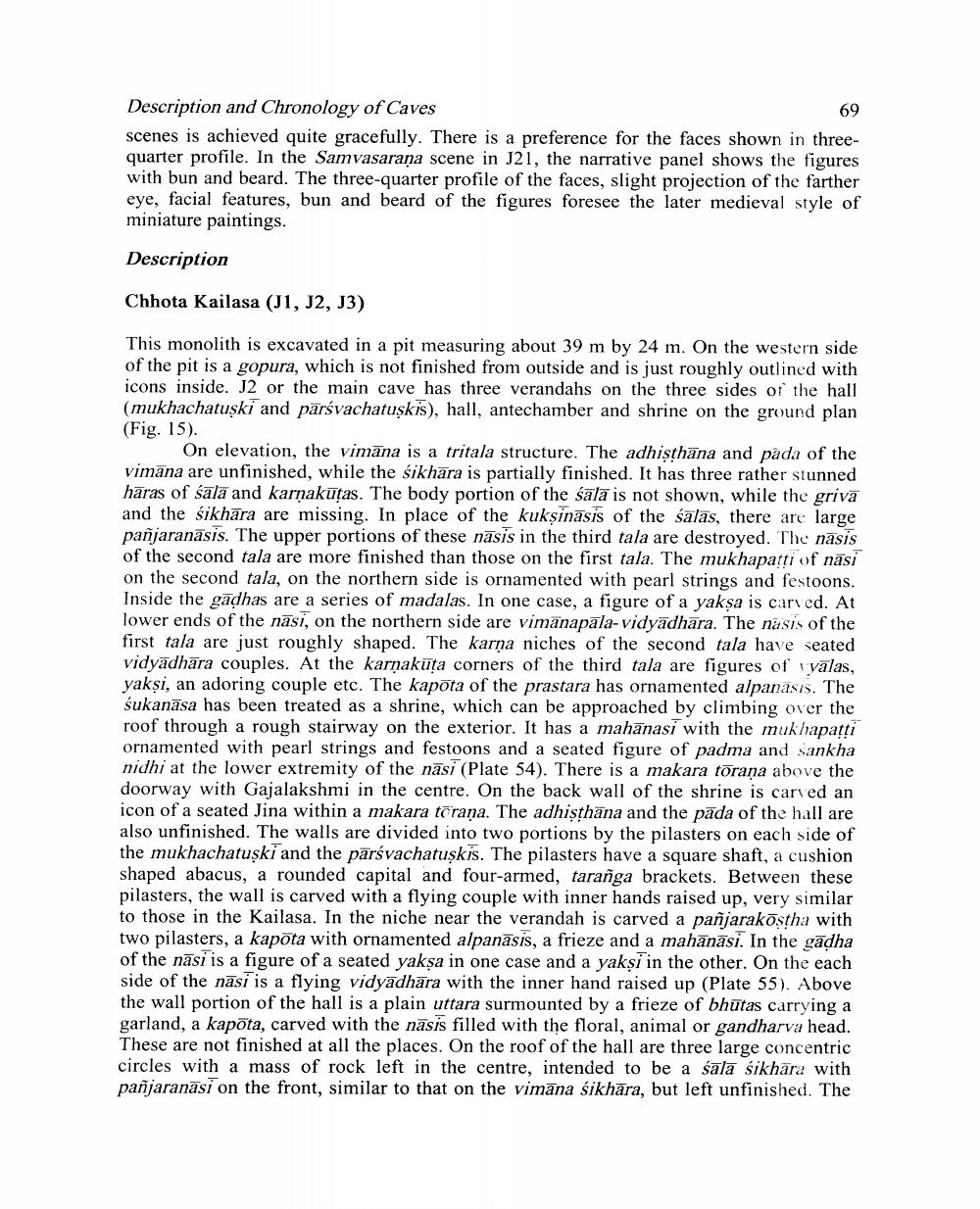________________
Description and Chronology of Caves
69
scenes is achieved quite gracefully. There is a preference for the faces shown in threequarter profile. In the Samvasarana scene in J21, the narrative panel shows the figures with bun and beard. The three-quarter profile of the faces, slight projection of the farther eye, facial features, bun and beard of the figures foresee the later medieval style of miniature paintings.
Description
Chhota Kailasa (J1, J2, J3)
This monolith is excavated in a pit measuring about 39 m by 24 m. On the western side of the pit is a gopura, which is not finished from outside and is just roughly outlined with icons inside. J2 or the main cave has three verandahs on the three sides of the hall (mukhachatuski and parsvachatuskis), hall, antechamber and shrine on the ground plan (Fig. 15).
On elevation, the vimana is a tritala structure. The adhiṣṭhāna and pada of the vimana are unfinished, while the śikhara is partially finished. It has three rather stunned hāras of śālā and karṇakūtas. The body portion of the sala is not shown, while the griva and the śikhara are missing. In place of the kukṣinasis of the salas, there are large pañjaranasis. The upper portions of these nasis in the third tala are destroyed. The nasis of the second tala are more finished than those on the first tala. The mukhapatti of nasi on the second tala, on the northern side is ornamented with pearl strings and festoons. Inside the gadhas are a series of madalas. In one case, a figure of a yakṣa is carved. At lower ends of the nasi, on the northern side are vimanapala-vidyadhara. The nasis of the first tala are just roughly shaped. The karna niches of the second tala have seated vidyadhara couples. At the karṇakuta corners of the third tala are figures of valas, yakşi, an adoring couple etc. The kapota of the prastara has ornamented alpanasis. The śukanasa has been treated as a shrine, which can be approached by climbing over the roof through a rough stairway on the exterior. It has a mahanasi with the mukhapatti ornamented with pearl strings and festoons and a seated figure of padma and Sankha nidhi at the lower extremity of the nasi (Plate 54). There is a makara tōraṇa above the doorway with Gajalakshmi in the centre. On the back wall of the shrine is carved an icon of a seated Jina within a makara toraṇa. The adhiṣṭhāna and the pada of the hall are also unfinished. The walls are divided into two portions by the pilasters on each side of the mukhachatuşki and the parávachatuşkis. The pilasters have a square shaft, a cushion shaped abacus, a rounded capital and four-armed, tarafga brackets. Between these pilasters, the wall is carved with a flying couple with inner hands raised up, very similar to those in the Kailasa. In the niche near the verandah is carved a pañjarakōṣṭha with two pilasters, a kapota with ornamented alpanasis, a frieze and a mahänäsi. In the gädha of the nasi is a figure of a seated yakṣa in one case and a yakṣi in the other. On the each side of the nasi is a flying vidyadhara with the inner hand raised up (Plate 55). Above the wall portion of the hall is a plain uttara surmounted by a frieze of bhutas carrying a garland, a kapota, carved with the nasis filled with the floral, animal or gandharva head. These are not finished at all the places. On the roof of the hall are three large concentric circles with a mass of rock left in the centre, intended to be a sala sikhara with pañjaranasi on the front, similar to that on the vimana sikhāra, but left unfinished. The




